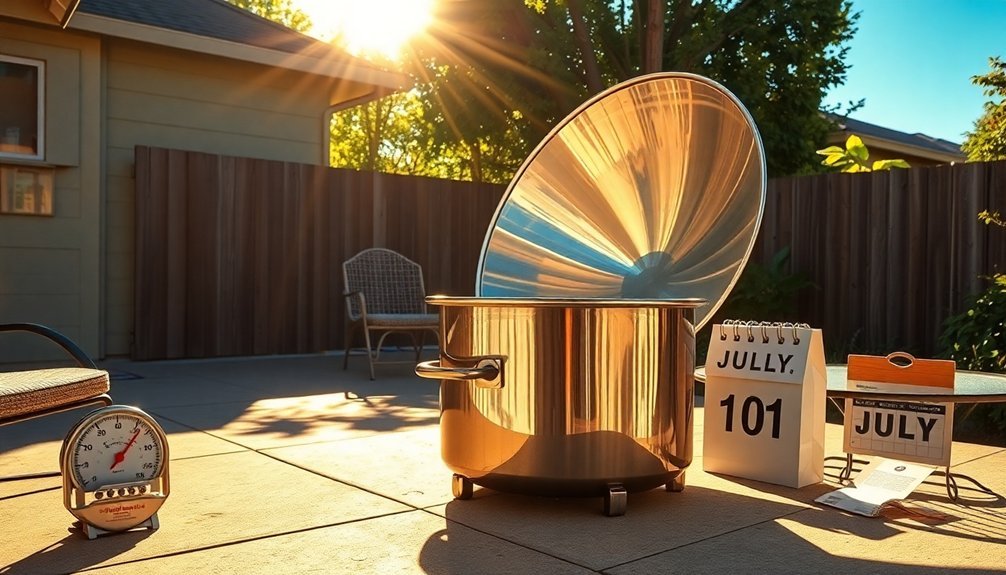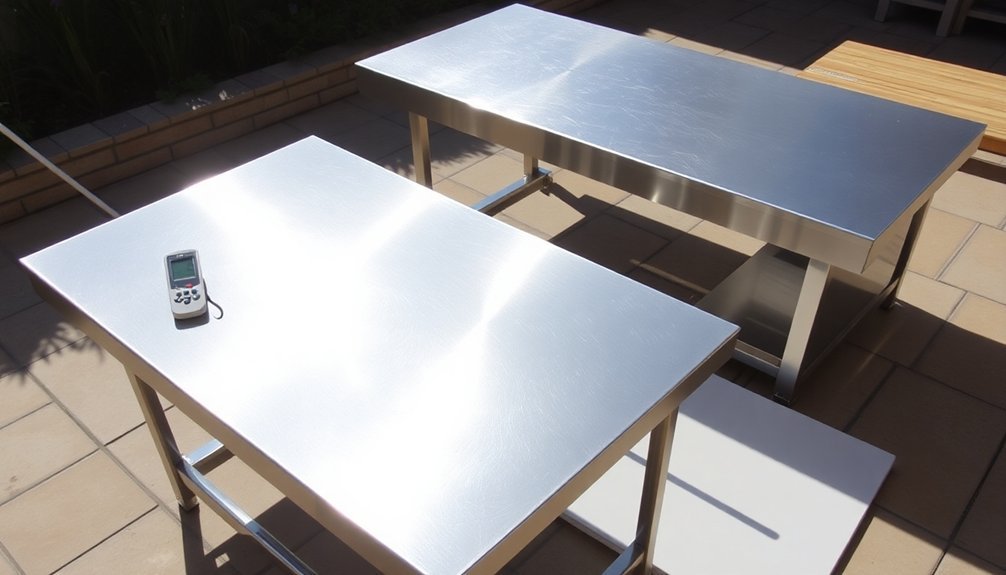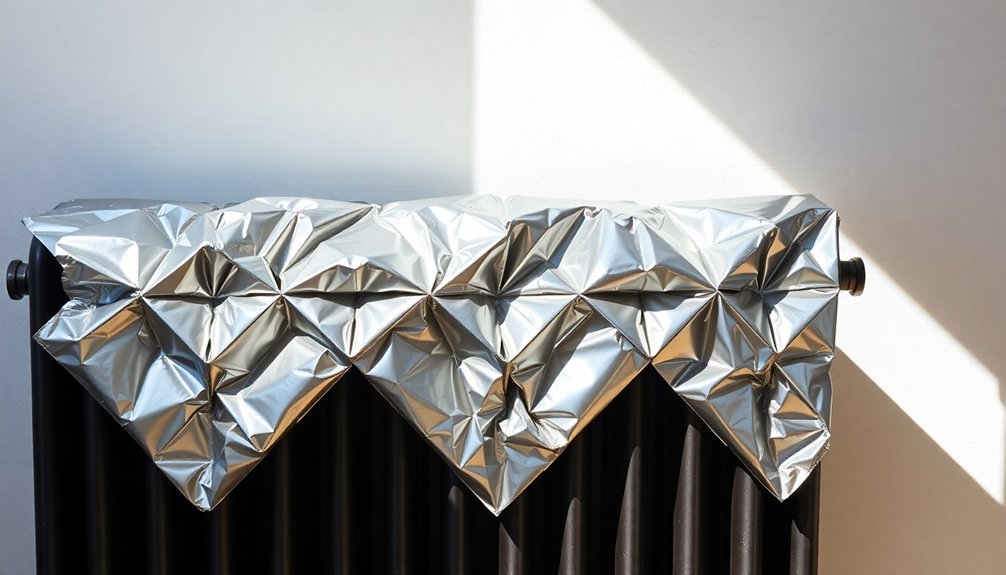You'll get the best solar cooking results from June through early September, when the sun is at its highest elevation and daylight hours are longest. For maximum efficiency, plan your solar cooking between 11 am and 3 pm, when sunlight is strongest. The summer solstice period offers peak performance with temperatures reaching 300-325°F in your solar cooker. While desert regions like Southern Arizona and Texas provide ideal conditions year-round, you can still achieve great results in most locations during summer months. Understanding how to adjust for your specific region and weather patterns will help you master this sustainable cooking method.
Peak Solar Cooking Calendar

Three key factors determine your ideal solar cooking calendar: the season, time of day, and geographic location.
You'll get the best results during summer and early fall months when the sun sits higher in the sky, providing longer and more intense sunlight hours.
For peak cooking efficiency, you'll want to plan your solar meals between 11:00 am and 3:00 pm, when the sun reaches its maximum intensity. Cold dry air can actually improve your solar cooking results due to reduced light scattering in the atmosphere.
If you live in regions like Southern Arizona or Texas, you'll benefit from consistently clear skies and minimal cloud cover throughout the year.
However, if you're cooking during late fall, winter, or early spring, you'll need to extend cooking times and adjust your cooker's position more frequently.
Consider using booster panels during these challenging months to enhance sun ray concentration.
Summer Solstice Success Strategies
The summer solstice offers peak solar cooking conditions that you won't find any other time of year. During this period, you'll experience the longest daylight hours and highest UV index levels, making it ideal for efficient solar cooking. Parchment paper liners can prevent food from sticking to cookware while solar baking during peak sunlight hours.
To maximize your success during the summer solstice, focus on timing your cooking between 11 am and 3 pm when sunlight is strongest.
- Use dark, non-reflective cookware to absorb maximum solar energy
- Position your solar oven to track the sun's movement throughout the day
- Maintain temperatures between 300-325°F by adjusting the oven's angle
- Choose versatile recipes that work well with varying UV levels
- Keep cooking times under 3.5 hours for meats to prevent overcooking
These strategies will help you harness the sun's peak energy during the solstice period, ensuring excellent cooking results.
Regional Solar Sweet Spots

Successful solar cooking depends heavily on your geographical location and regional climate patterns. If you're between the 60th parallels, you'll find solar cooking viable, with ideal results closer to the equator.
You'll get the best performance in desert regions like Southern Arizona and Texas, where clear skies dominate year-round.
Don't rule out solar cooking if you live in northern areas like Oregon or even London – you can still achieve good results, particularly during summer months between 11 AM and 3 PM. Peak efficiency occurs during the Summer Solstice period, making this the optimal time for solar cooking activities.
While coastal regions may face challenges from marine layers, and urban areas might deal with building shadows, you'll find success by choosing the right timing.
For best results, you'll want to cook when the UV index reaches 7 or higher, typically during summer's longer, clearer days.
Weather Pattern Impact Zones
While solar cooking offers an eco-friendly cooking method, specific weather patterns can greatly impact your success rate.
You'll find that your location plays a significant role in determining how effectively you can use a solar oven throughout the year. Coastal and high-latitude regions often present more challenges due to frequent cloud cover and limited direct sunlight.
- Cloudy and overcast conditions will extend your cooking times and may require backup cooking methods.
- High-latitude locations restrict your cooking windows, especially during winter months.
- Coastal areas demand more frequent oven adjustments due to variable weather.
- Mountain regions can still achieve high temperatures despite cold weather, thanks to clear skies.
- Snow reflection can actually boost your cooking efficiency if you position your oven strategically.
Consider these weather patterns when planning your solar cooking schedule to maximize success and guarantee reliable results.
Seasonal Cooking Time Adjustments

Adapting your solar cooking schedule throughout the year requires careful attention to seasonal shifts in daylight and sun intensity.
You'll need to make significant adjustments between summer and winter months to achieve best results.
During summer, you can enjoy efficient cooking between 10 a.m. and 4 p.m., with minimal need to reposition your solar oven. The sun's overhead position and high UV index create ideal conditions for consistent cooking.
However, winter months demand more patience and planning. You'll want to start earlier, adjust your oven's position more frequently, and expect longer cooking times due to the sun's lower position and reduced UV intensity.
Choose forgiving foods like beans and casseroles during winter, as they'll cook well at lower temperatures between 225-300 degrees.
Frequently Asked Questions
Can Solar Cooking Work Effectively at High Altitudes Above Sea Level?
Yes, you'll find solar cooking works at high altitudes, but you'll need longer cooking times due to lower boiling points and thinner air. You'll want to adjust your cooker more frequently for ideal results.
How Does Air Pollution and Smog Affect Solar Cooking Efficiency?
Air pollution and smog will greatly reduce your solar cooking efficiency by blocking and scattering sunlight. You'll experience longer cooking times and lower temperatures when there's heavy air pollution in your area.
What Backup Heating Methods Are Recommended on Partially Cloudy Days?
You'll want to allow extra cooking time, use thermal mass like bricks to store heat, employ thicker pots, and maintain good insulation. Keep a backup stove handy for when clouds persist.
Does Wind Speed Significantly Impact the Temperature of Solar Ovens?
Yes, wind will considerably decrease your solar oven's temperature. You'll notice longer cooking times when winds exceed 10 m/s (22 mph), as the breeze forces heat to escape and cools your oven more quickly.
Can Reflective Snow Cover in Winter Enhance Solar Cooking Performance?
Yes, reflective snow can enhance your solar cooking by increasing available sunlight through reflection, but you'll likely face longer cooking times due to cold temperatures offsetting the benefits of the additional reflected radiation.
In Summary
You'll get your best solar cooking results from May through August in most locations, when the sun's position and intensity are ideal. For peak performance, aim to cook between 10 AM and 2 PM during these months. Remember to adjust your cooking times and techniques based on your specific latitude and local weather patterns. Don't forget that even in ideal months, cloud cover will greatly impact your success.





Leave a Reply